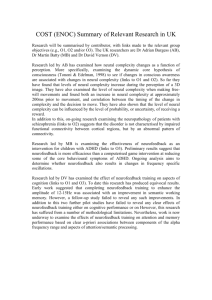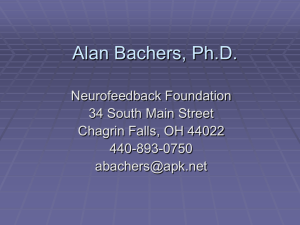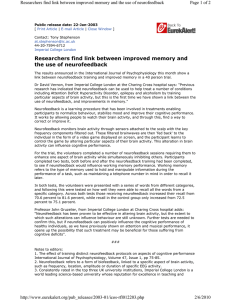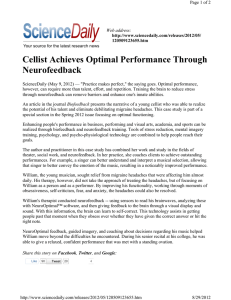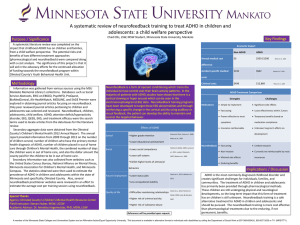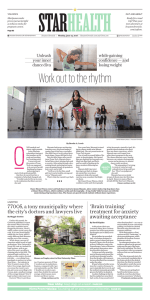Neurofeedback Essential Skills List
advertisement
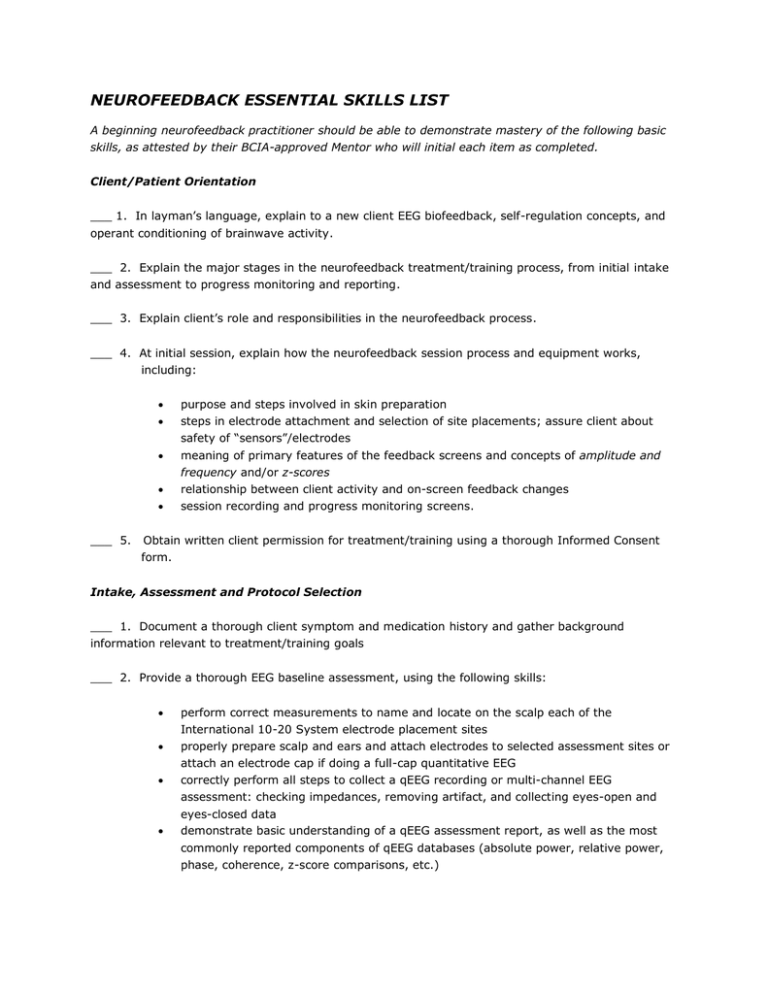
NEUROFEEDBACK ESSENTIAL SKILLS LIST A beginning neurofeedback practitioner should be able to demonstrate mastery of the following basic skills, as attested by their BCIA-approved Mentor who will initial each item as completed. Client/Patient Orientation ___ 1. In layman’s language, explain to a new client EEG biofeedback, self-regulation concepts, and operant conditioning of brainwave activity. ___ 2. Explain the major stages in the neurofeedback treatment/training process, from initial intake and assessment to progress monitoring and reporting. ___ 3. Explain client’s role and responsibilities in the neurofeedback process. ___ 4. At initial session, explain how the neurofeedback session process and equipment works, including: ___ 5. purpose and steps involved in skin preparation steps in electrode attachment and selection of site placements; assure client about safety of “sensors”/electrodes meaning of primary features of the feedback screens and concepts of amplitude and frequency and/or z-scores relationship between client activity and on-screen feedback changes session recording and progress monitoring screens. Obtain written client permission for treatment/training using a thorough Informed Consent form. Intake, Assessment and Protocol Selection ___ 1. Document a thorough client symptom and medication history and gather background information relevant to treatment/training goals ___ 2. Provide a thorough EEG baseline assessment, using the following skills: perform correct measurements to name and locate on the scalp each of the International 10-20 System electrode placement sites properly prepare scalp and ears and attach electrodes to selected assessment sites or attach an electrode cap if doing a full-cap quantitative EEG correctly perform all steps to collect a qEEG recording or multi-channel EEG assessment: checking impedances, removing artifact, and collecting eyes-open and eyes-closed data demonstrate basic understanding of a qEEG assessment report, as well as the most commonly reported components of qEEG databases (absolute power, relative power, phase, coherence, z-score comparisons, etc.) identify recordings indicating spike and wave activity requiring consultation with a neurologist or qEEG expert use all intake, psychometric, and baseline EEG assessment data to select target electrode placement sites and montages for neurofeedback treatment/training Select an initial neurofeedback protocol and explain rationale to client. Use and Maintenance of Neurofeedback Equipment ___ 1. Demonstrate thorough knowledge of operation of neurofeedback equipment of choice: Make correct hardware connections and start hardware. Make correct electrode connections to the hardware. Identify and remove (or control for) sources of common artifacts in the raw EEG signal. Troubleshoot common equipment failures according to manufacturer’s recommendations. ___ 2. Demonstrate thorough knowledge of appropriate software for selected equipment: Accurately select, install, and run neurofeedback treatment/training software. Identify components, applications, and limitations of selected software package. Neurofeedback Session Management and Reporting ___ 1. Conduct neurofeedback treatment/training sessions involving the following procedures: Provide initial orientation and instructions to client at first treatment/training session. Prior to subsequent sessions, query client (and/or parent) verbally and/or via presession questionnaire on client’s positive and negative reactions to previous session. Maintain basic hygiene procedures in attaching (and cleaning) electrodes. Remind client of the training objectives for session and their role in attending to and responding to feedback. Start treatment/training software program, set up selected protocol parameters, and run basic feedback functions. As appropriate, set initial training thresholds and adjust as needed. Identify and remove sources of artifact appearing in session recordings. Monitor session recordings and provide coaching and supplemental verbal feedback to client during sessions, as appropriate. Save session data per equipment guidelines and review session results with client. Assign homework to client that supports and supplements session training goals. Consult with client’s prescribing physician and/or providers of other concurrent treatments as necessary to avoid treatment complications and maximize treatment outcomes. Identify as soon as possible in the treatment/training process when neurofeedback is not working for a client; identify cause(s) for lack of progress; make necessary protocol or other training program adjustments; or, when necessary, recommend termination of neurofeedback. In collaboration with client, determine when neurofeedback treatment/training goals have been met and mutually plan for treatment termination and follow-up. Conduct all aspects of neurofeedback treatment and training in accordance with BCIA, AAPB and ISNR codes of ethical practice. ___ 2. Maintain orderly and up-to-date client files, including session-by-session training records, significant session events and client comments changes in client medication, significant life changes, allergies, etc. that may impact treatment/training results reports of consultations with other treatment providers, family members, teachers, etc. Use of Supplemental Therapeutic and Training Modalities ___ 1. Demonstrate ability to establish positive, constructive relationships with clients and their family members, using basic counseling and communication skills ___ 2. Document adequate training and demonstrate skills required to use appropriate counseling/therapy methods to supplement neurofeedback with clients having mental health diagnoses ___ 3. Document adequate training in use of alpha-theta neurofeedback protocols. Demonstrate ability to select appropriate clients for alpha-theta training as well as apply appropriate therapy methods when using these protocols ___ 4. Document adequate training in other neuromodulation modalities (such as HRV biofeedback, AVS, CES, etc.) for use in conjunction with neurofeedback, and demonstrate ability to select and use appropriate adjunctive modalities with individual clients. I attest that this work has been completed for: ____________________________________. Name of Candidate for BCIA Certification Signature of the Mentor: _______________________________________ Date: ______________ Printed Name of Mentor: _______________________________________ BCIA #:_____________ If using more than 1 mentor, please make copies of this document for each mentor to complete.

